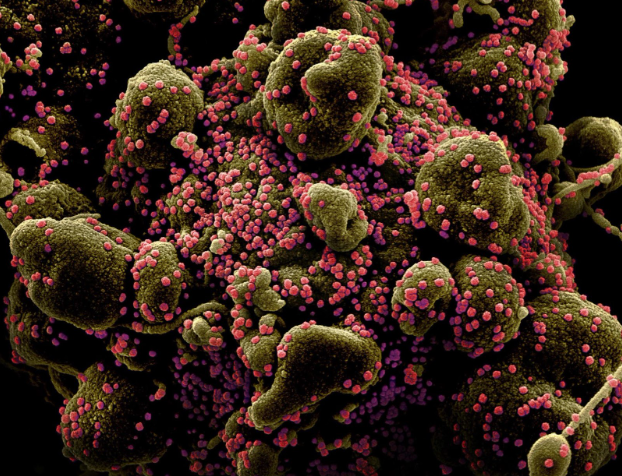COVID-19 Update June 3, 2020
- icshealthsciencejournal

- Jun 3, 2020
- 4 min read
Updated: Jun 10, 2020
This article contains:
Increased Effectiveness of Mask Filtration When Soaked in Saline
Moderna’s mRNA Vaccine
Increased Effectiveness of Mask Filtration When Soaked in Saline
Written By: Paphapin Pairojtanachai
In the American Journal of Infection Control, scientists indicate that a new study shows the impressive increase in the ability of kitchen and laboratory paper towels, as well as surgical masks, in filtering out particles as small as the SARS-CoV-19 virus (70-90 nm in diameter) when soaked in a saline solution and later dried. In an earlier study, surgical masks that had been treated with salt were able to block numerous strains of the influenza virus. This salt treatment can be used to enhance the quality of cloth and medical masks.
Jonathan Carnino, a research assistant in the department of pulmonology at the Boston University School of Medicine, said that the optimal situation is for healthcare workers to have an abundant amount of medical masks that would allow them to “change them out in-between patients.” However, during this global pandemic, when there is an undersupply of masks, “an extra layer of protection makes it more acceptable to be reusing masks throughout a shift. It's an added level of safety for those risking their lives on the front lines.” Carnino also added that “You can't expect every single healthcare worker to cut open their masks and take out the filters. We wanted to use common household products.”
Carnino explained the reason behind this phenomenon that when NaCl is dissolved in an aqueous solution, molecular bonds are formed and a lattice is built in the towel. “When a nanoparticle hits the treated paper towel, the salt dissolves for a second and when it dries, creating a lattice again, it encapsulates the virus.”
In the earlier study done with the influenza virus, Carnino and his colleagues dissolved salt with water and added a surfactant, or a substance that reduces the surface tension of the liquid, thus allowing the salt to cover a wider area of the paper towel. In the new research, they did the same thing with a kitchen paper towel, a laboratory paper towel, and a surgical mask filter. They then dropped a liquid consisting of fluorescent outer membrane vesicles (OMVs), which are similar in size to the coronavirus, onto the treated materials. The results revealed that “the pretreated paper towel was [an even] better filter than the untreated surgical mask filter.” The researchers then duplicated the experiment without the surfactant, yielding a similar outcome. This means that people can perform the treatment to amplify the effectiveness of their face masks themselves without needing a surfactant.
Dr. Catherine Clase, an associate professor of medicine at McMaster University in Hamilton, Ontario, Canada, and a nephrologist at St. Joseph's Hamilton Healthcare, mentioned that this is “an interesting proof-of-concept,” as “it will be interesting to see whether this translates into blocking particles in an aerosol experiment” as well.
Below is Jonathan Carnino’s recipe for the salt pretreatment method:
Measure out 100 mL of water (preferably distilled water as that was used in the study)
Heat the water lightly until it is hot to the touch
Add 30 g or 5 tsp of table salt and mix until completely dissolved
Soak household paper towel pre-cut to the size and shape of a surgical mask or N95 respirator in the solution for 5 minutes
Allow the material to dry completely
Secure the pretreated paper towel to the outside of a homemade mask, surgical mask, or N95 respirator and replace approximately every 2 hours or sooner if stained
Moderna’s mRNA Vaccine
Written By: Kandharika Bamrungketudom
Unlike the “traditional” type of vaccine, the vaccine that is currently being tested on humans made by Moderna, which is an American biotech company that focuses on drug discovery and development, is an “mRNA Vaccine.” In traditional vaccines, inactive viruses or their proteins are injected into the human body so that the human body can create antibodies against the specific antigens that are injected. The drawback here is that it takes a long time for scientists to actually grow and inactivate the germs. An mRNA vaccine, however, works through the injection of the virus’ mRNA (the virus’ genetic material) inside lipid coating into the human’s body. Once inside the human body, the lipid coating facilitates the mRNA’s entrance into cells. Inside the cells, the ribosomes synthesize the virus’ antigen according to the instructions from the mRNA. These antigens are harmless on their own. They are then sent to the antigen presenting cells, which allow for the formation of antibodies.
The method of utilizing the mRNA vaccine allows for faster development of vaccines since this method does not involve the growing of germs, which could take weeks. According to Margaret Liu, the chairman of the board for the International Society of Vaccines, the mRNA vaccine also has the potential to create a vaccine that works against multiple strains of virus. The mRNA vaccine type for other strains of virus has been developed for around thirty years and modifications have been implemented to decrease adverse effects. However, no successful mRNA vaccine has been licensed for human use yet — hopes are that Moderna’s coronavirus vaccine may be the first one.
Phase 1 of the vaccine trial for Moderna’s mRNA vaccine has shown to be somewhat successful since data has shown that the vaccine is safe. The first phase of the vaccine trial has also achieved to determine the safest dosage for the vaccine. Moderna’s vaccine is now going through phase 2 of the vaccine trial, with 600 participants from 10 sites and 8 states in the US involved.
Phase 3 of Moderna’s vaccine, according to Dr. Anthony Fauci, is also scheduled to begin in July. This trial is to include 30,000 patients, aging from around 18 to 55. It will take place primarily in the US, but will also include some international sites as well. If the vaccine indeed passes this trial, it would be on the way to be approved by the US Food and Drug Administration, which allows for it to be manufactured for patients. The results of the third phase of the trial is to come out around November or December of this year.









Comments